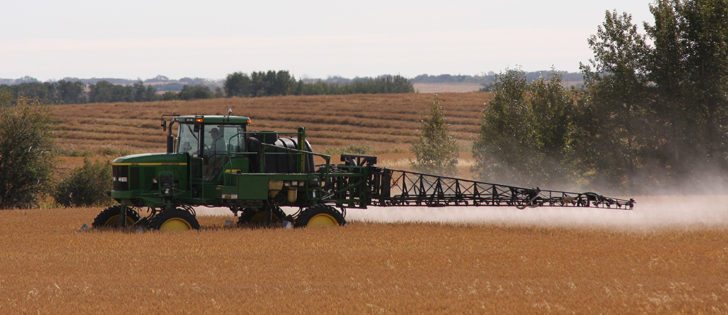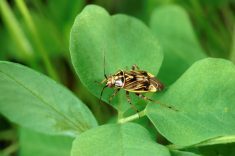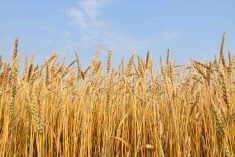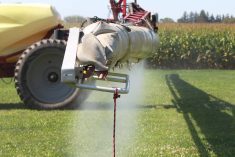CORRECTION – The headline of this story originally stated glyphosate was found in 4 percent of food samples. The correct number is 1.3 per cent of food samples. Glyphosate was found in 4 percent of grain samples.
Health Canada has found that glyphosate exceeds maximum residue limits in grain products about four percent of the time.
The finding is from a Canadian Food Inspection Agency document that an agency employee emailed to U.S. Right to Know, a non-profit group that campaigns for a transparent food system. The four page report is titled Safeguarding with Science: Glyphosate Testing in 2015-2016. (PDF format)
Read Also

Farming Smarter receives financial boost from Alberta government for potato research
Farming Smarter near Lethbridge got a boost to its research equipment, thanks to the Alberta government’s increase in funding for research associations.
A CFIA spokesperson confirmed that it is an agency document and the information is accurate
The document summarizes CFIA testing of 3,188 food samples for glyphosate, the active ingredient in Roundup and the most popular herbicide in the world.
The Agency began testing for glyphosate in 2015 to get a sense of the presence and levels of the herbicide in foods.
CFIA scientists tested fresh produce, processed fruits and vegetables, grain products, juice and other beverages, bean-pea-lentil products, soy products and baby food. They compared the amount of glyphosate in the food to the maximum residue limit (MRL) allowed for that product.
They tested:
• 869 grain products and found glyphosate in 36.6 percent of samples. 3.9 percent of samples had residues above the MRL.
• 869 bean-pea-lentil products and found glyphosate in 47.4 percent of samples. Only 0.6 percent were over the MRL.
• 82 samples of baby cereals. They detected glyphosate in 31.7 percent of samples. No samples exceeded the MRL.
• 127 samples of baby food. They found glyphosate in 30.7 percent of samples. No tests exceeded the MRL.
• 263 soy products. Glyphosate was detected in 11 percent of samples but none were above the MRL
• 496 juice and beverage samples. Around 16 percent of samples had residues and 0.2 percent exceeded the MRL
Overall, glyphosate was detected 29.7 percent of the time in 3,188 food samples. Only 1.3 percent of samples were above the MRLs.
“Most samples found with levels of residues exceeding Canadian limits were predominantly associated with grain products,” the report said.
The document doesn’t provide information on the amounts of glyphosate in the food samples, and it doesn’t tell Canadians if certain grain products were significantly higher than the residue limits or marginally above the MRL.
It omits the types and names of grain products, such as breakfast cereals, that may have exceeded the MRL.
The CFIA, in an email to The Western Producer, said it doesn’t plan to release such information.
“The report (on glyphosate residues) will not include raw data, company or brand names.”
The agency is withholding those details for confidentiality reasons.
“Information about individual companies and products are not included in the reports because the relationships between distributors and manufacturers of specific products may be confidential business information.”
Many Canadians have been waiting for the CFIA report on glyphosate residues because the herbicide has become extremely controversial.
Last year the European Union came close to banning it because of a scientific report from the World Health Organization.
In March of 2015 the WHO’s International Agency for Research on Cancer (IARC) concluded that glyphosate is “probably carcinogenic” to humans.
Many toxicologists have condemned the IARC decision because numerous agencies, including Health Canada, the European Food Safety Authority and the European Chemicals Agency, have studied the herbicide. They all concluded that it’s not carcinogenic and not a threat to human health.
Despite the body of evidence showing it’s safe, the IARC report triggered lawsuits in the U.S.
Consumer and environmental groups are suing companies over glyphosate residues in foods like granola bars and honey.
The state of California may soon require that Roundup and glyphosate have a label saying it’s a cancer threat because of the IARC ruling.
In its report, CFIA scientists said Canadians don’t need to worry about glyphosate residues in food.
“This data was evaluated by Health Canada and no human health concerns were identified.”
The agency will be posting the document on its website as a chemical residue report.
A CFIA spokesperson said the agency hasn’t decided when it will publish the document.
Health Canada maximum residue limits for glyphosate:
Barley 10 parts per million
Bean 4 p.p.m.
Lentil 4 p.p.m.
Pea 5 p.p.m.
Soybean 20 p.p.m.
Wheat 5 p.p.m.
General MRL 0.1 p.p.m.
(for other products)
Source: Health Canada
Contact robert.arnason@producer.com


















